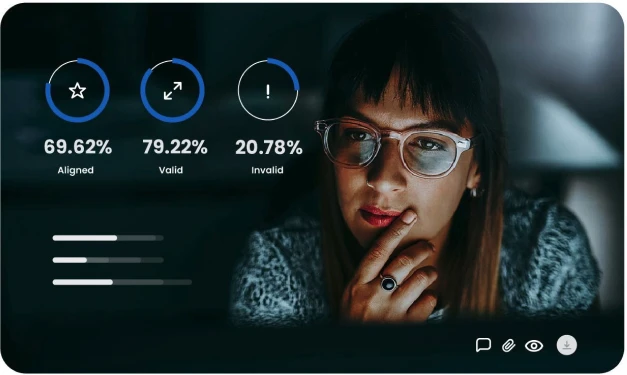DMARC FAQs
What is a DMARC record?
A DMARC record is a DNS TXT record published in a domain’s DNS database that tells receiving mail servers what to do with messages that don’t align or authenticate with SPF and DKIM. The DMARC record enables reports to be sent back to the domain owner about which messages are authenticating and why.
What does a DMARC record look like?
All DMARC rulesets are specified in the DMARC record. A DMARC record enables email sending organizations to inform ISPs (like Gmail, Microsoft, Yahoo!, etc.) whether a domain has implemented DMARC. 𠊊 DMARC record is published in the DNS as a TXT record and the TXT record name can be set as “_dmarc.yourdomain.com.” where “yourdomain.com” is replaced with the organization’s actual domain name (or subdomain).
DMARC TXT record example: v=DMARC1; p=none; rua=mailto:example@example.com; ruf=mailto:example@ example.com; fo=1;
The DMARC policy instructs email receivers how to process emails that they receive and is also published in the DMARC record. When deploying DMARC, there are three policies available that can be published to eventually work towards an enforced reject policy that instructs email receiving systems to only accept legitimate messages.
Available DMARC policies:
- None (monitoring only)
- Quarantine
- Reject
Monitor policy: p=none
The none (monitoring only) policy: p=none. This policy enables organizations to instruct email receiving systems to send DMARC reports to the address published in the RUA or RUF tag of the DMARC record. The monitoring only policy helps to gain insights on an email channel as it provides information on who is sending email on behalf of a domain. The p=none policy will not affect the email deliverability.
Quarantine policy: p=quarantine
The quarantine policy: p=quarantine. Besides sending DMARC reports, the quarantine policy instructs email receiving systems to deliver email that are not DMARC compliant into the spam folder. Enforcing the p=quarantine policy will mitigate the impact of spoofing although spoofed emails will still be delivered to the receiver (spam folder).
Reject policy: p=reject
The reject policy: p=reject. Besides sending DMARC reports, the DMARC policy reject instructs email receiving systems to reject all (malicious) messages that are not DMARC compliant and to deliver all DMARC compliant emails into the primary inbox.
This enforced DMARC policy significantly mitigates the impact and risk of spoofing.
How does DMARC email security work?
DMARC enables an organization to publish policies to its DNS record that define its practices for email authentication and provides instructions for receiving mail servers about how to enforce them. Essentially, DMARC helps receiving mail servers determine if an incoming message “aligns” with what is known about the sender, and how to handle messages that don’t align.
Specifically, DMARC enables receiving mail servers to check for alignment between the “header from” domain name and the “envelope from” domain name that is used during SPF authentication, and alignment between the “header from” domain name with the “d= domain name” in the DKIM signature.
If a message fails both SPF and DKIM authentication and alignment, receiving mail servers can check the sender’s DMARC email security policy to decide whether to accept, block or quarantine the email message. DMARC also reports the outcome of this decision back to the sending domain owner, providing clearer insight into messages sent from the domain.
What are the benefits of DMARC email security?
Benefits of implementing DMARC email security include:
- Prevention of phishing and certain spoofing attacks. Once DMARC has been properly implemented, it can help protect an organization against certain kinds of cyberattacks.
- Greater visibility. By reporting on outbound email sent from an organization’s domain, the DMARC email security framework provides insight into all messages ostensibly sent from the organization’s domain or from third-party providers used by the organization.
- Troubleshooting delivery issues. Using DMARC provides insight into problems with email authentication with SPF and DKIM.
What is DMARC’s ability to protect against spoofing?
DMARC can help to successfully prevent direct domain spoofing, where attackers use an organization’s exact domain name in the “from” address within an email. However, DMARC cannot prevent look-alike domain spoofing, where attackers use a domain name that is a slightly altered version of a legitimate domain. Also, DMARC cannot prevent display name spoofing, where the name of the sender appears to be a trusted contact even though the underlying “from” email address may not be legitimate. And DMARC can’t provide protection against newly registered domains that are often used to initiate attacks for several hours or days before being shut down. For these reasons, most organizations opt for a multilayered approach to email security that uses DMARC in association with a variety of other defenses.





